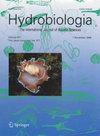网络理论在流域排水网络模型中的应用:案例研究Quindío哥伦比亚部门
IF 0.3
4区 生物学
Q4 MARINE & FRESHWATER BIOLOGY
引用次数: 1
摘要
背景:位于南美洲哥伦比亚的昆迪奥省流域水文网络受到制革、采矿、食品加工等行业的污染。目标:使用图形表示流域的水文网络,并研究其最具代表性的中心性度量;作为一个案例研究,我们考虑了昆迪奥省流域的水文网络。方法:运用网络理论,分析度分布、PageRank、偏心率等中心性测度;拓扑度量,如密度和协调性。结果:该研究为研究河网特性提供了一种不同的方法。等级分布显示了一个输入等级为一、二和三的网络,而输出等级仅为一或零,与典型的山地盆地一致。密度和分类性等测量结果显示,低密度网络没有定义的连接模式。根据水文网络的连接方式,PageRank和离心率的中心性突出了主要原因和最重要的河流。结论:该研究得出结论,通过使用网络理论,我们获得了网络的全局视野,了解了网络的结构,并使我们能够直观地看到网络的哪些区域是脆弱的。PageRank的中心性使我们能够识别网络中监控良好的节点和需要护理的节点;这种相同的分布突出了网络中更容易受到污染的区域。最后,离心率将网络中心(“La Maria”的扇区)确定为网络最脆弱的区域之一。本文章由计算机程序翻译,如有差异,请以英文原文为准。
Application of the theory of networks to model a drainage network of a watershed: case study Department of Quindío Colombia
Background: The hydrographic network of the basins of the department of Quindio, located in Colombia, South America, suffers from pollution due to industries such as tanneries, mining, food processing, among others. Goals: Represent a hydrographic network of a basin employing a graph and study its most representative measures of centrality; as a case study, we considered the hydrologic network of the basins of the department of Quindio. Methods: The theory of networks and the analysis of centrality measures such as degree distribution, PageRank, and eccentricity; also, topological measures such as density and assortativity. Results: The study provided a different approach to research on the properties of river networks. The grade distribution shows a network with input grades of one, two, and three, while the output grade is only one or zero, consistent with a typical mountain basin. Measurements such as density and assortativity showed a low-density network with no defined connection patterns. The centrality of PageRank and eccentricity highlighted the leading causes and the most important rivers according to the way the hydrographic network is connected. Conclusions: The study concluded that by using network theory, we obtained a global vision of the network, understanding its structure and allowing us to visualize which areas of the network are vulnerable. PageRank’s centrality allowed us to identify well-monitored nodes in the network and those that need care; this same distribution highlighted zones in the network that are more prone to contamination. Finally, the eccentricity determined the center of the network (sector of “La Maria”) as one of the network’s most vulnerable areas.
求助全文
通过发布文献求助,成功后即可免费获取论文全文。
去求助
来源期刊

Hidrobiologica
生物-海洋与淡水生物学
CiteScore
0.40
自引率
0.00%
发文量
8
审稿时长
>12 weeks
期刊介绍:
HIDROBIOLÓGICA es una publicación cuatrimestral que difunde trabajos originales e inéditos de investigación o revisión, sobre temas relacionados con los organismos y la hidrología de los ambientes acuáticos, dulces y marinos y va dirigida a investigadores de todo el mundo, interesados en las diversas disciplinas que incluye la Hidrobiología , así como a alumnos de posgrados y licenciaturas relacionados con la biología, ecología, taxonomía, filogenia y evolución de organismos acuáticos, e hidrología y oceanografía de ambientes s dulceacuícolas y marinos.
 求助内容:
求助内容: 应助结果提醒方式:
应助结果提醒方式:


